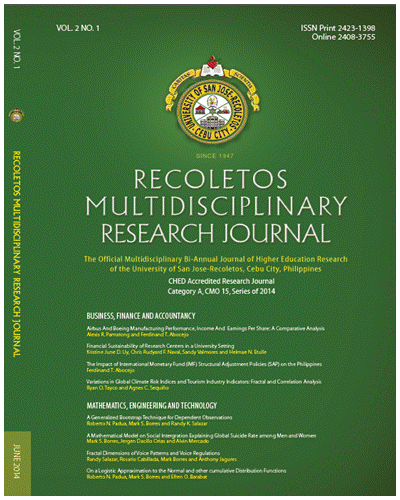Verification on the Impact of Plant Cover Variability to the Anuran Diversity in Bohol, Philippines Using Fractal Analysis
DOI:
https://doi.org/10.32871/rmrj1402.01.20Keywords:
Anurans, fractal correlation, plant covers, fractal dimension, novel methodAbstract
This study attempted to analyse the impact of the diversity of plant covers of the different sites of Bohol, Philippines to the diversity of Anurans. The researchers utilized a novel method of analysis in the nature of geometrical fractal and statistical analysis where the following are computed: 1.) the number of species per site per cover (agricultural/forest) 2.) the record of species of the respective covers 3.) the fractal dimension of the relationship that exists between 1 and 2 were calculated in five (5) trials. The centroid
regression approach was used to determine the strength of relationship and the degree of impact of the variability in the plant covers to the diversity of Anurans in the area. The fitted regression line (with R-sp. of 91.9%) states that Anuran species’ diversity increased the number of the plant covers in both agricultural and forest increased. In fact, for every unit increased the number of species they cover increased the Anuran species’ diversity to approximate 46%. Moreover, fractal correlation in terms of the diversity of plant covers explained the increase in the diversity of Anurans’ species where implication for policies on
greening tree planting and environmental protection could be advanced.
References
Protection Agency, Environmental Research Laboratory.
Alados C.L., Pueyo Y., Navas D., Cabezudo B., Gonzales A. and Freeman D.C. (2005). Fractal analysis of plant spatial patterns: a monitoring tool for
vegetation transition shifts. Biodiversity and Conservation 14: 1453–1468, 2005. Springe DOI10.1007/s10531-004-9669-3
Alcala, A.C. (1986). Guide to Philippine Flora and Fauna. Vol. X, Amphibians and Reptlies.Natural Resource Management Center, Ministry of Natural Resources and the University of the Philippines.195 pp.
Alcala, A.C. and Brown, W.C. (1998). Philippine Amphimbians: An Illustrated Field Guide. Bookmarked Incorporated, Makati City.
Andres, M.I.C. (2009). Taxonomic survey of frog and toad species (order Anura) in the Rajah Sikatuna Protected Landscape Bohol, Philippines
Baillie, J.E.M., Hilton-Taylor, C. and Stuart, S.N. 2004 (eds.). 2004 IUCN Red List of Threatened Species.A Global Species Assessment.IUCN,
Gland, Switzerland and Cambridge, UK. Retrieved from: http://www.iucnredlist.org/initiatives/amphibians/process/publications
Brown, RM, Diesmos, A.C., Alcala, A.C. (2008). Philippine Amphibian Biodiversity is Increasing in Leaps and Bounds. In: Threatened Amphibians of the World. Lynx Ediciones. Barcelona, Spain. Stuart SN, Hoffmann M, Chanson JS, Cox NA, Berridge R, Ramani P, Young BE. eds.
IUCN, Gland, Switzerland; and Conservation International, Arlington, Virginia, USA: p. 82–83.
Chambers, J. (2008) Terrestrial habitat requirements of a suite of anuran species inhabiting a semiarid region of South East Queensland.PhD thesis, Queensland University of Technology.
Chaturved A. & Prasad, P R C. (2013) Application of fractal geometry in determining optimal quadrat size for vegetation sampling. CURRENT
SCIENCE, VOL. 105, NO. 9,
Diesmos A. C., Diesmos M. L., Brown R. M. (2006). Status and Distribution of alien invasive frogs in the Philippines. Journal of Environmental Science and Management, Philippines 9:41-53.
Duellman, W.E. (1999). Patters of Distribution of Amphibians: A Global Perspective Retrieved from: http://books.google.com.ph/books?id=2WScSPkvY0AC&pg=PA76&lpg=PA76&dq=anurans+diversity&source=bl&ots=vVBqJKj5ye&sig=PRhPcSwiGfnHqGgC1HiJwT5gEe0&hl=fil&sa=X&ei=c7nsUvmtJsbGkQWgjICYAw&ved=0CGsQ6AEwCQ#v=onepage&q=anurans%20diversity&f=false
Eterovick P C. (2003). Distribution of anuran species among montane streams in south -eastern Brazil. Journal of Tropical Ecology, 19, pp 219-
228.doi:10.1017/S0266467403003250.
Faruk A, Belabut D, A. N; Knell RJ, Garner TW. (2013). Effects of oil-palm plantation on diversity of tropical anurans. 27(3):615-24. doi: 10.1111/cobi.12062
Gray, M. J., Smith, L., Brenes, R. (2004). Effects of agricultural cultivationnon demographic of southern high plains amphibians. Conservation Biology Vol. 18 No. 5 Pages 1368-1377
Heaney, L.H. & Regalado, J. C. (1998).Vanishing Treasure of the Philippines Rain Forest.The Field Museum, Chicago, IL. USA.
Heying, H. (2003.)â€Anura†(On-line), Animal Diversity Web. Accessed February 01, 2014 at http://animaldiversity.ummz.umich.edu/accounts/
Anura/
Hopkins, W. G., (1998). Quantitative Research Design. Retrieved from: http://www.sportsci.org/resource/design/design.html
Inger, R.F. 1954. Systematics and Zoogeography of Philippine Amphibia.Feildiana33:261-264
Jelinek H., Jones C., Warfel, Lucas C., Depardieu C., Aurel G. (2005). Understanding fractal analysis? The case of fractal linguistics.Retrieved from http://www.biourbanism.org/understanding-fractalanalysis-case-fractal-linguisics/
Jose, R.P. (2012). Distribution of Anuran Species in Loboc Watershed of Bohol Island, Philippines. Vol. 3, #86, pp.126-141 January 2012 Asian
Journal of Biodiversity CHED Accredited Research Journal, Category A Print ISSN 2094-1519 Electronic ISSN 2244-0461 doi:http://dx.doi.org/10.7828/ajob.v3i1.86
Microbeatic (2012) Diversity Index: Shannon Index/Shannon-Weaver Index (H). retrieved from http://microbeatic.wordpress. com/2012/01/26/diversity-index -shannonindexshannon-weaver-index-h/
Padua, R.; Palompon, D.; Ontoy, D.(2012) Data Roughness and Fractal Statistics (CNU Journal of Higher Education Research, CHED-JAS Category A, Vol. 7, no.2)
Olsen E.R, Ramsey R.D, Winn D.S. (1993). A modified fractal dimension as a measure of landscape diversity.Photogrammetric Engineering &
Remote Sensing. Vol. 59, No. 10, October 1993, pp. 1517-1520. Retrieved froms http://www.gis.usu.edu/~doug/pubs/fractal.pdf
Shah, A. 2014.“Biodiversityâ€.Global Issues. Retrieved from http://www.globalissues.org/issue/169/biodiversity
Shannon C.E. and Weaver W. (1949).The Mathematical Theory of Communication. University of Illinois Press, Urbana, Illinois.
Vasudevan K., Kumar A., Noon BR., Chellam R.(2008). Density and diversity of forest floor anurans in rain forest of Southern Western Ghat, India. Herpetologica 64(2):207-215.doi: http://dx.doi.org/10.1655/07-066.1
Downloads
Published
How to Cite
Issue
Section
License
Copyright of the Journal belongs to the University of San Jose-Recoletos


